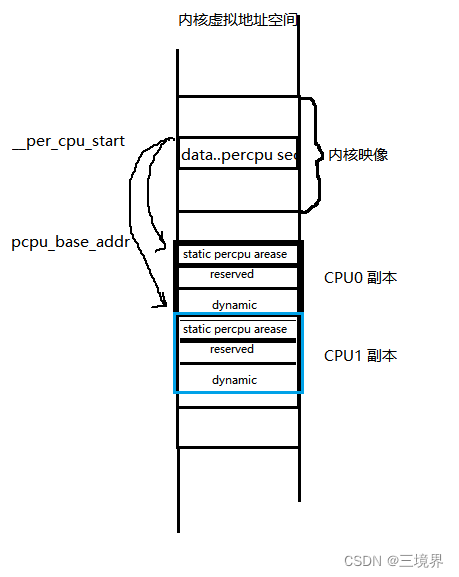linux -- per-CPU变量
per-CPU变量
per-CPU变量是一种存在与每个CPU本地的变量,对于每一种per-CPU变量,每个CPU在本地都有一份它的副本。
per-CPU变量的优点
- 多处理器系统(smp)中无需考虑与其他处理器的竞争问题(并非绝对的)
- 可以利用处理器本地的cache硬件,提高访问速度
per-CPU变量的分类
按照分配内存空间的类型来看,有两种:
- 静态per-CPU变量
- 动态per-CPU变量
静态的per-CPU变量在编译期就静态分配,动态per-CPU变量在程序运行时动态分配。
per-CPU变量的实现机制
静态per-CPU变量
相关宏
90 #ifndef PER_CPU_BASE_SECTION
91 #ifdef CONFIG_SMP
92 #define PER_CPU_BASE_SECTION ".data..percpu"
93 #else
94 #define PER_CPU_BASE_SECTION ".data"
95 #endif
96 #endif
定义和声明
4/*
5 * Base implementations of per-CPU variable declarations and definitions, where
6 * the section in which the variable is to be placed is provided by the
7 * 'sec' argument. This may be used to affect the parameters governing the
8 * variable's storage.
9 *
/*
per-CPU变量声明和定义的基础实现,变量被放置的section由sec参数提供,这被用于影响管理参数变量的存储方式
注意!用于声明和定义的sections必须匹配,以免由于编译器生成错误的代码来访问该节而发生链接错误。
*/
10 * NOTE! The sections for the DECLARE and for the DEFINE must match, lest
11 * linkage errors occur due the compiler generating the wrong code to access
12 * that section.
13 */
14#define __PCPU_ATTRS(sec) \
15 __percpu __attribute__((section(PER_CPU_BASE_SECTION sec))) \
16 PER_CPU_ATTRIBUTES
17
18#define __PCPU_DUMMY_ATTRS \
19 __attribute__((section(".discard"), unused))
20#ifdef HAVE_MODEL_SMALL_ATTRIBUTE
21# define PER_CPU_ATTRIBUTES __attribute__((__model__ (__small__)))
22#endif
73 * Normal declaration and definition macros.
74 */
75#define DECLARE_PER_CPU_SECTION(type, name, sec) \
76 extern __PCPU_ATTRS(sec) __typeof__(type) name
77
78#define DEFINE_PER_CPU_SECTION(type, name, sec) \
79 __PCPU_ATTRS(sec) PER_CPU_DEF_ATTRIBUTES \
80 __typeof__(type) name
81#endif
83/*
84 * Variant on the per-CPU variable declaration/definition theme used for
85 * ordinary per-CPU variables.
86 */
87#define DECLARE_PER_CPU(type, name) \
88 DECLARE_PER_CPU_SECTION(type, name, "")
90#define DEFINE_PER_CPU(type, name) \
91 DEFINE_PER_CPU_SECTION(type, name, "")
这么多宏,最后其实就是DEFINE_PER_CPU和DECLARE_PER_CPU最重要。
举个例子:
DECLARE_PER_CPU(int, python);
DEFINE_PER_CPU(int, python);
被展开为:
extern __percpu __attribute__((section("data..percou"))) int python;
__percpu __attribute__((section("data..percou"))) int python;
这里的定义实际把python变量放到.data…percpu段里。
看链接脚本:kernel/vmlinux.lds
定义了percpu区域的输出段,简单版本,需要对齐
所有percpu变量都会放到这个段里,__per_cpu_start和__per_cpu_end分别用于标识该区域的起始地址与终止地址。
在C代码中使用外部变量:extern char __per_cpu_load[], __per_cpu_start[], __per_cpu_end[];来引用他们。
108 INIT_TEXT_SECTION(PAGE_SIZE)
109 . = ALIGN(16);
110 INIT_DATA_SECTION(16)
111 PERCPU(4)
676/**
677 * PERCPU - define output section for percpu area, simple version
678 * @align: required alignment
679 *
680 * Align to @align and outputs output section for percpu area. This
681 * macro doesn't maniuplate @vaddr or @phdr and __per_cpu_load and
682 * __per_cpu_start will be identical.
683 *
684 * This macro is equivalent to ALIGN(align); PERCPU_VADDR( , ) except
685 * that __per_cpu_load is defined as a relative symbol against
686 * .data.percpu which is required for relocatable x86_32
687 * configuration.
688 */
689#define PERCPU(align) \
690 . = ALIGN(align); \
691 .data.percpu : AT(ADDR(.data.percpu) - LOAD_OFFSET) { \
692 VMLINUX_SYMBOL(__per_cpu_load) = .; \
693 VMLINUX_SYMBOL(__per_cpu_start) = .; \
694 *(.data.percpu.first) \
695 *(.data.percpu.page_aligned) \
696 *(.data.percpu) \
697 *(.data.percpu.shared_aligned) \
698 VMLINUX_SYMBOL(__per_cpu_end) = .; \
699 }
setup_per_cpu_areas函数
DEFINE_PER_CPU(int, python)只是将python变量放到了.data…percpu 的 section中,如何让系统中每个CPU都拥有一份该变量的副本?
linux内核委托setup_per_cpu_areas函数完成变量副本生成,并且对per-CPU变量的动态分配机制进行初始化。
静态per-CPU变量副本的产生
setup_per_cpu_areas函数做了这些事:
-
计算.data…percpu section的空间大小 static_size= __per_cpu_end - __per_cpu_start,此为所有用DEFINE_PER_CPU及其变体说定义出的静态per-CPU变量所占用空间的总大小。对于模块使用的per-CPU变量,以及动态分配的per-CPU变量,内核在初始化时后会为他们预留空间,也即下图的reserved和dynamic部分
-
调用alloc_bootmem_nopanic来分配一段内存,用于保存per-CPU变量的副本。(系统内存管理组件还没建立,使用的是引导期内存分配器)。这块内存要依赖于系统中CPU的数量,因为要给每个CPU创建变量的副本。每个CPU变量副本所在内存空间被称为一个unit,代码中nr_unit是SoC上CPU的数量,每个unit的大小记为unit_size。unit_size = PFN_ALIGN(static_size + reserved_size + dyn_size)。 副本所在空间的大小就是nr_units* unit_size。pcpu_base_addr指向副本空间起始地址。
-
经过步骤2,已经为副本创建了容纳他们的内存空间。步骤3开始将.data…percpu section中变量数据赋值到pcpu_base_addr空间,这一步就是下图两条箭头所做的事。

setup_per_cpu_areas函数的实现:
3292void __init setup_per_cpu_areas(void)
3293{
3294 unsigned long delta;
3295 unsigned int cpu;
3296 int rc;
3297
3298 /*
3299 * Always reserve area for module percpu variables. That's
3300 * what the legacy allocator did.
3301 */
3302 rc = pcpu_embed_first_chunk(PERCPU_MODULE_RESERVE,
3303 PERCPU_DYNAMIC_RESERVE, PAGE_SIZE, NULL,
3304 pcpu_dfl_fc_alloc, pcpu_dfl_fc_free);
3305 if (rc < 0)
3306 panic("Failed to initialize percpu areas.");
3307
3308 delta = (unsigned long)pcpu_base_addr - (unsigned long)__per_cpu_start;
3309 for_each_possible_cpu(cpu)
3310 __per_cpu_offset[cpu] = delta + pcpu_unit_offsets[cpu];
3311}
动态 per-CPU变量副本的产生
per-CPU变量使用案例
一个非常典型的案例:计数器
per-CPU变量非常适合做统计计数,内核专门有一个给予per-CPU变量设计的计数器(lib/percpu-counter.c)
比如在网络子系统中,要计算系统接受到的各类网络包的数量,这些包更新的频率是极快的,这就需要percpu的支持,系统中每个处理器都有这么一个对网络包数量进行计量的副本,变量更新时无需考虑多处理器竞争问题,想算出总数是只需将所有处理器的同一percpu副本相加即可。
